固有免疫细胞及功能(英文)
免疫学题库加答案(全)
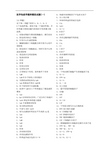
医学免疫学题库模拟试题(一)[A1型题]以下每一考题下面有A、B、C、D、E5个备选答案,请从中选一个最佳答案。
并在答题卡将相应题号的相应字母所属方根涂黑。
1.实验动物新生期切除胸腺后,淋巴结内A.深皮质区缺乏T细胞B.生发中心生成受影响C.胸腺依赖区T细胞数目和生发中心均不受影响D.深皮质区T细胞缺乏,同时生发中心形成也受影响E.浅皮质区无明显影响2.免疫对机体A.有利B.有害C.有利又有害D.无利也无害E.正常情况下有利,某些条件下有害3.IgMA.IgM在分子结构上有铰链区B.天然的血型抗体为IgMC.IgG的溶血作用比IgM强D.在个体发育中合成较晚E.血清中IgM由4个单体通过了链连成四聚体4.IgGA.IgG以单体形式存在,广泛分布于体液中B.IgG4固定补体的能力最强C.IgG半衰期相对较短D.为天然血型抗体E.不参与ADCC反应5.寄生虫感染时明显水平升高的Ig是A.IgGB.IgAC.IgMD.IgDE.IgE6.补体A.具有相应受体B.具有抗感染作用C.经典途径成分包括C1—9 D.体液补体抑制因子中包括H因子E.以上均正确7.补体经典途径的成分包括A.C1qB.IgG1C.IL—2D.H因子E.B因子8.具有过敏毒素作用的是A.G5aB.C1qC.C3D.I因子E.H因子9.具有调理作用的是A.抗原B.抗原和补体C.抗体和补体D.补体E. 抗体10.下列由淋巴细胞产生的细胞因子是A.IL—2B.IFN—γC.IL—4D.IL一10B.以上均是11.最早发现的细胞因子A.IGFβB.IFNC.SCFD.IL—10B.LIF12.下列英文缩写含义正确的是A.EPO-血小板生成素B.IL-白细胞介素C.SCF-肿瘤坏死因子D.TNF-集落刺激因子E.CSF-干细胞生长因子13.浆细胞瘤和B细胞杂交瘤生长因子是A.IFN—α、TNF一αB.TNF—α、IL—1C.IL—2、IFN—γD.IL—6E.IL—6、IL—114.可使NK细胞成为LAK细胞的是A.IL一1B.IL—2C.IL—3D.IFN—αE.IL—1015.MHC—I类分子的功能A.为CD8+杀伤性T细胞的识别分子B.参与外源性抗原呈递C.参与内源性抗原呈递D.A十BE.A十C16. 在诱发同种免疫反应中,免疫原性最强的细胞是A.T淋巴细胞B.富含HLA—PR抗原细胞C.多形核细胞D.肥大细胞E.红细胞17.编码HLA·I类分子基因位点A.HLA—A、B位点B.HLA—A、B、c位点C.HLA—DR位点D. HLA—DR、DP、DQ位点E.C4、C2、TNF、21经化酶基因位点18.仅表达HLA—I类分子A.红细胞B.淋巴细胞C.血小板D.单核细胞E.B淋巴细胞,单核细胞19.有丝分裂原A.刀豆素AB.植物血凝素C.美洲商陆丝裂原D.细菌脂多糖E.以上均是20.MHC—I类分子的配体是A.CD2B.CD3C.CD4D.CD8E.CDlO21.属于免疫球蛋白超家族的分子是A.CD4B.VLA一1C.PNA—dD.E-caderinE.CD222.B细胞表面特有的标志是;A.E受体B.pHA受体C.C3b受体D.抗原受体(SmIgM/D)E.IL—2受体23.促进造血干细胞分化为髓系和淋巴系干细胞的是A.IL—lB.IL—2C.IL—3D.IL一8E.EPO24.调控I型超敏反应的是A.巨噬细胞B.T细胞C.B细胞D.NK细胞E.嗜酸性粒细胞25.具有抗原呈递功能的是A.辅助性T细胞B.杀伤性T细胞C.抑制性T细胞D.B细胞E.NK细胞26.单核吞噬细胞系统细胞功能A.吞噬并清除病原微生物B.清除衰老细胞,维持机体内环境稳定C.抗原呈递作用D.杀伤肿瘤细胞E.以上均是27.能分化为巨噬细胞的前体细胞是A.单核细胞B.B细胞C.T细胞D.嗜酸性粒细胞E.红细胞28.AFP是A.异种抗原B.同种异型抗原C.异嗜性抗原D.自身抗原E.肿瘤相关抗原[B1型题]以下提供若干组考题,每组考题共用在考题前列出的A、B、C、D、E5个备选答案,请从中选择一个与问题关系最密切的答案,并在答题卡上将相应题号的相应字母所属方框涂黑。
固有免疫的组成及其应答

精选版课件ppt
14
1.NK细胞的来源和发育 ●来源于淋巴样前体细胞。 ●出生后来源于骨髓。
精选版课件ppt
15
2.NK细胞受体
●识别HLA-I类分子的杀伤活化或抑制受体
(1)杀伤细胞免疫球蛋白样受体(KIR)
抑制性受体:KIR2DL、KIR3DL
(4)抗原提呈作用
(5)免疫调节作用:
分泌细胞因子IL-1、IL-6、精选IL版-8课、件pIpLt -12和TNF-α等。
13
(三)NK细胞 (natural killer cell,自然杀伤细胞)
特点: 大颗粒淋巴细胞(large gΒιβλιοθήκη anular lymphocyte,
LGL)——胞浆中含嗜天青颗粒。 TCR-、mIg-、CD56+、CD16+(FcγR)
精选版课件ppt
20
(二)细胞因子
病原体感染机体后,可刺激免疫细 胞和感染的组织细胞产生多种细胞因子, 引起炎症反应,发挥抗病毒、抗肿瘤和 免疫调节等作用。
精选版课件ppt
21
(三)抗菌肽及酶类物质
(1)防御素:是一组耐受蛋白酶、富含精氨酸的小分子
多肽,对细菌、真菌和某些有囊膜病毒具有直接杀伤作用。
表面某些共有的特定分子结构。主要包括
脂多糖、肽聚糖、磷壁酸、甘露糖、磷脂
酰丝氨酸等。
精选版课件ppt
29
精选版课件ppt
30
甘露糖受体的配基: 主要是甘露糖和岩藻糖残基等。
甘露糖受体的功能: 促进巨噬细胞对病原体(如分枝杆
菌、克雷伯菌、卡氏肺孢子菌和酵母菌 等)的吞噬作用。
精选版课件ppt
畜禽免疫基础知识

③递呈抗原功能
巨噬细胞具有递呈细菌抗原的功能。首先在吞 噬体内将细菌杀死,然后通过溶酶体的酶将其降解 为抗原决定簇,与细胞内合成的MHC-Ⅱ类分子结合
(二)适应性免疫细胞-淋巴细胞(lymphocyte)
1、T细胞(Thymus dependent lymphocyte , T ) (1)发育和分布:来源于骨髓多能干细胞。干细胞 从血流进入胸腺后,在胸腺素、白细胞介素-7等诱导 下经过10~30d分化、增殖,98%凋亡,2%左右成熟为 T细胞,主要分布于胸腺、淋巴结副皮质区、脾脏白 髓、粘膜下,大量进行淋巴细胞再循环。
细胞分化:在个体发育中,细胞后代在形态、结构和功能
上发生差异的过程。
全能性干细胞:细胞含有使后代细胞形成完整个体的潜能
称全能性,这种细胞称全能性干细胞。 多能性干细胞:细胞具有分化出多种组织的潜能,但却失 去了发育成完整个体的能力称为多能性,这种细胞称为多 能性干细胞。
单能性干细胞:只能分化出一种细胞的干细胞称单能性干
2、脾脏(Spleen):
是机体最大的免疫器官,含大量B细胞,少量T细胞,除 具有与淋巴结相似的功能外,还有造血和清除自身衰老的 血细胞和免疫复合物的功能。 (1)细胞组成:脾脏内含有大量巨噬细胞、B细胞和T细
胞,B细胞占65%,T细胞占35%,是抗体产生的主要器官。
(2)构造:
红髓:网状细胞,巨噬细胞,浆细胞, 各种血细胞。 脾脏 淋巴鞘:T细胞 白髓 脾小结:B细胞→生发中心
2、特异性。
一种病原微生物刺激机体产生免疫力只能保 护一种疾病,具有高度的特异性。原因在于一种 抗原刺激机体只能产生一种与之相对应的抗体, 是一一对应关系。
固有免疫细胞AIM2炎性体通路在抗HCMV免疫机制中的作用
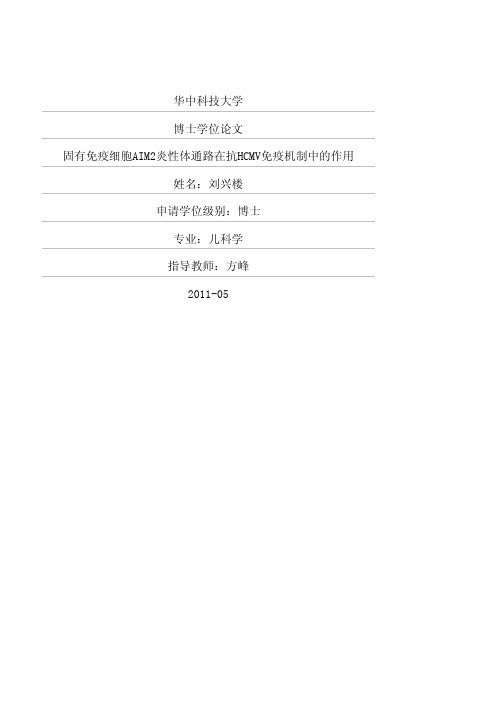
华中科技大学博士学位论文固有免疫细胞AIM2炎性体通路在抗HCMV免疫机制中的作用姓名:***申请学位级别:博士专业:儿科学指导教师:***2011-05华 中 科 技 大 学 博 士 学 位 论 文 固有免疫细胞AIM2炎性体通路在抗HCMV免疫机制中的作用中文摘要【目的】① 证实AIM2是识别HCMV的DNA感受器;② 明确HCMV 感染THP-1源性巨噬细胞对AIM2炎性体通路中各信号分子的影响;③ 证实AIM2炎性体通路参与抗HCMV固有免疫促炎细胞因子反应。
【方法】① 建立HCMV感染THP-1源性巨噬细胞模型:HCMV(AD169株)以MOI=1接种至已用PMA刺激分化的THP-1细胞,建立HCMV感染THP-1源性巨噬细胞模型,同时设立模拟感染对照组、LPS+ATP对照组和poly(dA:dT)对照组;② Real-time RT-PCR法定量检测HCMV感染组和模拟感染对照组DNA感受器AIM2、polIII、DAI和TLR9基因转录水平;③ Real-time RT-PCR法定量检测HCMV感染组和模拟感染对照组IL-1ß基因转录强度;④ 在HCMV感染后1 h、3 h、6 h、12 h和24 h,用western blot法检测HCMV感染组、模拟感染对照组和LPS+ATP对照组AIM2、ASC、Caspase-1和IL-1ß蛋白表达变化;并设立转染poly(dA:dT)后24 h的poly(dA:dT)对照组;⑤ 用针对AIM2和ASC的siRNA,分别转染THP-1源性巨噬细胞,转染后24 h再感染HCMV AD169毒株,并设模拟转染对照组。
在感染后6 h,用Western blot法检测细胞内AIM2、ASC、Caspase-1和IL-1ß蛋白表达,并与模拟感染对照组比较;⑥ 用特异性Caspase-1抑制剂(Ac-YVAD-CHO)处理THP-1源性巨噬细胞后,再感染HCMV AD169毒株,同时设模拟处理对照组,在感染后6 h,用Western blot检测细胞内AIM2、ASC、Caspase-1、pro-IL-1ß和IL-1ß蛋白表达水平,并与模拟感染对照组计较。
医学免疫学英文词汇

AAcquired immune deficiency syndrome, AIDS 获得性免疫缺陷综合征(艾滋病) Acquired immunity 获得性免疫Activation induced cell death, AICD 活化诱导的细胞死亡Active immunotherapy 主动免疫治疗Acute phase protein 急性时相蛋白Adapter 转接蛋白Adaptive immunity 适应性免疫Addressin 地址素Adenosine deaminase 腺苷脱氨酶Adjuvant 佐剂Adoptive immunity 过继免疫Adoptive immunotherapy, AIT 过继免疫治疗Affinity 亲和力Affinity maturation 亲和力成熟Agglutination 凝集反应Allelic exclusion 等位排斥Allergen 变应原Allergin 变应素Allergy 变态反应Allogenic antigen 同种异型抗原Allograft 同种异型移植Allotype 同种异型Allorecognition 同种异型识别Alpha-fetoprotein, AFP 甲种胎儿球蛋白Alternative pathway 旁路途径Anamnestic response 回忆应答Anaphylactic shock 过敏性休克Anaphylactogen 过敏原Anaphylaxis 过敏反应Anchor residue 锚定残基Ankylosing spondylitis, AS 强直性脊柱炎Antibacterial immune serum 抗菌免疫血清Antibody, Ab 抗体Antibody-dependent cell-mediated cytotoxicity, ADCC 抗体依赖性细胞介导的细胞毒作用Antiviral immune serum 抗病毒免疫血清Antigen, Ag 抗原Antigenic determinant 抗原决定簇Antigen internal image 抗原内影像Antigen-presenting cells, APC 抗原提呈细胞Antigen specific immune response 抗原特异性免疫应答Antigenicity 抗原性Anti-idiotype 抗独特型Antitoxic serum 抗毒素血清Apoptosis 细胞凋亡Apoptosis cell associated molecular pattern, ACAMP凋亡细胞相关的分子模式 Apoptotic body 凋亡小体Artificial active immunization 人工主动免疫Artificial passive immunization 人工被动免疫Ataxia telangiectasia syndrome, AT 毛细血管扩张共济失调综合征 Atopic dermatitisAutocrineAutograftAutoimmune antibodyAutoimmune disease, AIDAutoimmune hemolytic anemiaAutoimmune thrombocytopenic purpuraAutoimmunityBBacillus Calmette Guerin, BCGBare lymphocyte syndrome, BLSBasophilB cell epitope BB cell hybridoma BB cell linker ptotein, BLNKB cell receptor, BCRBiotin-avidin system, BASBispecific antibody, BsAbBlocking antibodyB lymphocyteBone marrowBone marrow transplantation, BMTBradykininCC1 inhibitor, C1 INHC4 binding protein,C8 binding protein, C8bpC-reactive protein,CRPCadherinCalcineurinCalmodulinCarcinoembryonic antigen, CEACarrierCecropinsCell adhesion molecules, CAM 特应性皮炎自分泌自体移植自身抗体自身免疫性疾病自身免疫性溶血性贫血自身免疫性血小板减少性紫癜自身免疫卡介苗裸淋巴细胞综合征嗜碱性粒细胞细胞表位细胞杂交瘤 B 细胞连接蛋白 B 细胞(抗原识别)受体生物素-亲和素系统双特异性抗体封闭抗体 B淋巴细胞骨髓骨髓移植缓激肽C1抑制分子 C4bp C4 结合蛋 C8 结合蛋白 C-反应蛋白钙粘蛋白钙神经素(钙调磷酸酶)钙调蛋白癌胚抗原载体杀菌肽细胞粘附分子hediak-Higashi syndrome Chediak-Higashi综合征 Chemokine 趋化性细胞因子 Chimeric antibody 嵌合抗体Chronic granulomatous disease, CGD 慢性肉芽肿病 Class Ⅱtransactivator, C Ⅱ TA Ⅱ类反式活化子 Class switch 类别转换Classical pathway 经典途径Clonal anergy 克隆无能Clonal deletion 克隆删除Clonal eliminationClonal expansionCluster of differentiation, CDColony stimulating factor, CSFCommon variable immunodeficiencyComplementComplement deficiencyComplement receptorComplementarity determining region, CDRComplete antigenConcanavalin A, Con AConformational determinantConstant regionCo-receptorCo-stimulating signalCo-stimulatory molecules, CMCo-stimulatory molecule receptor, CMR Cross reactionCryptic determinantCytokine, CKCytolytic typeCytotoxic typeCytotoxic T lymphocytes, CTL 或 Tc Cytotoxic T lymphocytes antigen-4, CTLA-4 DDecay accelerating factor, DAFDefensinsDelayed type hypersensitivity, DTHDelayed type hypersensitivity T cell, T DTH Dendritic cells, DCDiGeorge syndromeDiversity geneDNA vaccineDonorDouble immunodiffusion 克隆消除克隆扩增分化群集落刺激因子普通变化型免疫缺陷病补体补体缺陷补体受体互补性决定区完全抗原刀豆蛋白A 构象决定基恒定区,C区辅助受体协同刺激信号协同刺激分子协同刺激分子受体交叉反应隐蔽决定基细胞因子细胞溶解型细胞毒型细胞毒性T细胞细胞毒性T淋巴细胞(相关)抗原 4 衰变加速因子防御素迟发型超敏反应迟发型超敏反应性T细胞树突状细胞 DiGeorge综合征 D(多样化)基因 DNA疫苗供者双向免疫扩散Double negative cell, DN cell 双阴性细胞Double positive cell, DP cell 双阳性细胞EE rosette test E 花结试验Early phase reaction 早期相反应Endocytosis 胞吞作用Enzyme immunoassay, EIA 酶免疫测定Enzyme linked immunosorbent assay, ELISA 酶联免疫吸附试验Eosinophil, Eos 嗜酸性粒细胞Eosinophil chemotactic factor, ECF 嗜酸性粒细胞趋化因子Eosinophil peroxidase, EPO 嗜酸性粒细胞过氧化物酶 Epitope 表位Erythropoietin, EPO 红细胞生成素Extracellular matrix, ECM 细胞外基质F Fc receptor, FcR 结晶片断受体,Fc受体 Flow cytometry, FCM 流式细胞术Fluorescence-activated cell sorter, FACS 荧光活化细胞分类器 Follicular dendritic cells, FDC 滤泡树突状细胞 Fragment antigen binding, Fab 抗原结合片断Fragment crystallizable, Fc 结晶片断Fragment of variable region Fv 片断Framework region 骨架区Freund complete adjuvant 弗氏完全佐剂GGenetic engineering antibody 基因工程抗体Germ line gene 胚系基因Germinal center 生发中心Glycosylphosphatidylinositol, GPI 糖磷脂酰肌醇Graft versus host reaction, GVHR 移植物抗宿主反应 Granule exocytosis 颗粒胞吐Granulocyte colony stimulating factor, G-CSF 粒细胞集落刺激因子 Granulocyte-macrophage colony stimulating factor, GM-CSF 粒细胞-巨噬细胞集落刺激因子 Granzyme, Gz 颗粒酶Grave disease 毒性弥漫性甲状腺炎 Growth factor 生长因子Growth factor receptor binding protein-2,Grb-2 生长因子受体结合蛋白 2 Guanine nucleotide exchange factor, GEF 鸟苷酸置换因子Gut-associated lymphoid tissue, GALT 肠伴随(相关)淋巴组织 HHaplotype 单元型Hapten 半抗原Hashimoto’s thyroiditis 桥本甲状腺炎Heat shock protein, HSP 热休克蛋白Heavy chain 重链,H 链Helper T cells(lymphocytes), Th 辅助性 T 细胞 Hemolytic plaque assay 溶血空斑试验 Hemopoietic stem cell, HSC 造血干细胞 Heterophil antigen 异嗜性抗原 Hidden antigen 隐蔽抗原High endothelial venule, HEV 高内皮细胞小静脉 Hinge region 铰链区Histamin 组胺Histocompatibility antigen-2, H-2HLA genotypingHomologous restriction factor, HRFHost versus graft reaction, HVGRHuman immunodeficiency virus, HIVHuman leukocyte antigen,HLAHumanized antibodyHumoral immunity Hypersensitivity Hypervariable region, HVRIIdiotype, IdIdiotype networkImmediate hypersensitivity Immune adherent, IAImmune complex, ICImmune function related gene Immune regulationImmune responseImmune response region Immune serumImmune surveillanceImmune systemImmunityImmunocyteImmunodeficiency disease, IDD Immunofluorescence ImmunogenicityImmunoglobulin, IgImmunoglobulin superfamily, IgSFImmunohistochemistry techniqueImmunological competenceImmunological ignorance , ;Immunological toleranceImmunological non-responsiveness 小鼠的组织相容性抗原HLA 基因分型同源限制因子宿主抗移植物反应人类免疫缺陷病毒人类白细胞抗原人源化抗体体液免疫超敏反应高变独特型独特型网络速发型超敏反应免疫粘附免疫复合物免疫功能相关基因免疫调节免疫应答免疫应答区免疫血清免疫监视免疫系统免疫免疫细胞免疫缺陷病免疫荧光法免疫原性免疫球蛋白免疫球蛋白超家族免疫组化技术免疫适能免疫忽视免疫耐受免疫不应答Immunologically privileged sites 免疫隔离部位Immunology 免疫学Immunoreceptor tyrosine-based activation motifs, ITAM 免疫受体酪氨酸活化基序 Immunoreceptor tyrosine-based inhibitory motifs, ITIM 免疫受体酪氨酸抑制基序 Immunotherapy 免疫治疗Inactivated vaccine 灭活疫苗Inducible nitric oxide synthase, iNOS 诱导型一氧化氮合成酶Inflammatory cell 炎症细胞Innate immunity 固有(性)免疫Inositol-1, 4, 5-trisphosphate,IP3Insulin-dependent diabetes mellitus, IDDM Intercellular adhesion molecular,ICAMIntegrinInterferon, IFNInterleukin, ILInternalizationImtraepithelial lymphocytes, IELJJoining chainJoining geneKKiller activatory receptor, KARKiller inhibitory receptor, KIRKiller immunoglobulin like receptor KininogenaseLLangerhans cells, LCLarge granular lymphcytes, LGLsLate phase reactionLectinLectin-like carbohydrate recognition domain, CRDLeucine rich repeat, LRRLeukinLeukocyte adhesion deficiency, LADLeukocyte common antigen, LCALeukocyte differentiation antigen, LDALeukotrienes (Leucotrienes), LTsLigandLight chainLinker for activation of T cell, LATLinear determinantLinkage disequilibriumLipoteichoic acid, LTALipoxygenase pathway 三磷酸肌醇胰岛素依赖型糖尿病细胞间粘附分子整合素干扰素白细胞介素内化上皮细胞间淋巴细胞 J链J基因杀伤细胞活化受体杀伤细胞抑制受体杀伤细胞免疫球蛋白样受体激肽原酶郎格汉斯细胞大颗粒淋巴细胞晚期相反应凝集素凝集素样糖识别结构域富含亮氨酸的重复序列白细胞素白细胞粘附缺陷白细胞共同抗原白细胞分化抗原白三烯配基,配体轻链,L 链 T细胞活化连接蛋白线性决定基连锁不平衡磷壁酸脂氧合酶途径Live-attenuated vaccine 减毒活疫苗Long-acting thyroid stimulator, LATS 长效甲状腺刺激素Low molecular-weight polypeptide, LMP 低分子量多肽LPS binding protein, LBP LPS结合蛋白Lymphocyte 淋巴细胞Lymphocyte function associated antigen, LFA 淋巴细胞功能相关抗原 Lymphocyte homing 淋巴细胞归巢Lymphocyte homing receptor, LHR 淋巴细胞归巢受体Lymphoid DC 淋巴系树突状细胞Lymphoid progenitor 淋巴样祖细胞Lymphoid stem cells, LSC 淋巴样干细胞Lymphokine, LK 淋巴因子Lymphokine activated killer cell, LAK 淋巴因子激活的杀伤细胞 Lymphotoxin, LT 淋巴毒素β -lysin 乙型溶素Lysosome-associated membrane proteins-1,LAMP-1 溶酶体相关膜蛋白1 Lysozyme 溶菌酶MMacrophages, M φ巨噬细胞Macrophage colony stimulating factor, M-CSF 巨噬细胞集落刺激因子 Macropinocytosis 巨吞饮Magainins 爪蟾抗菌肽Major histocompatibility complex, MHC 主要组织相容性复合体 Mannan-binding lectin, MBL 甘露糖结合凝集素Mannose binding protein, MBP 甘露糖结合蛋白Mannose receptor, MR 甘露糖受体Mast cell, MC 肥大细胞MBL-associated serine protease, MASP MBL 伴随的丝氨酸蛋白酶 Membrane attack complex, MAC 膜攻击复合物Membrane cofactor protein, MCP 膜辅助因子蛋白Membrane Ig, mIg 膜表面免疫球蛋白Membrane inhibitor of reactive lysis, MIRL 膜反应性溶解抑制物 Memory cells 记忆细胞MHC class Ⅰ gene MHC Ⅰ类基因MHC class Ⅱ gene MHC Ⅱ类基因MHC class Ⅲ gene MHC Ⅲ类基因MHC restriction MHC 限制性Microfold cell M细胞,微小褶皱细胞β 2-Microglobulin, β2 -m β2 微球蛋白Minor histocompatibility antigen 次要组织相容性抗原 Mitog en 丝裂原Mitogen-activation protein kinase, MAPK 丝裂原激活蛋白激酶 Molecular mimicry 分子模拟Monoclonal antibody, McAb 单克隆抗体第7 / 11页Monocyte 单核细胞Monocyte chemotactic protein, MCP 单核细胞趋化蛋白Monokine, MK 单核因子Mononuclear-phagocyte system, MPS 单核-巨噬细胞系统Mucosal-associated lymphoid tissue, MALT 粘膜伴随(相关)淋巴组织 Mucosal mast cell, MMC 粘膜肥大细胞Multiple hematopoietic stem cells, HSC 多能造血干细胞Multiple sclerosis, MS 多发性硬化症Myasthenia gravis, MG 重症肌无力Myeloid DCMyeloid stem cellMyeloperoxidase, MPONNaive T(B) cellsNatural cytotoxic cellNature killer cell, NK cellNeutrophilsNitric oxide, NONitroblue tetrazolium, NBTNon-classical MHC class Ⅰ geneNon-organ specific autoimmune diseaseNon-specific immunityNude miceOOpsonizationOrgan specific autoimmune diseasePParacrineParoxysmal nocturnal hemoglobineria, PHNPassive immunotherapy ,Passive transfer of lymphocytePathogen associated molecular pattern, PAMPPattern recognition receptor, PRRPeptide antibioticsPeptidoglycan, PGNPerforinPeripheral lymphoid organPeyer’s patchesPhagocytePhagocytosisPhagolysosomePhosphatidylinnosital pathway 髓系树突状细胞髓样干细胞髓过氧化物酶初始T(B)细胞自然细胞毒性细胞自然杀伤细胞嗜中性粒细胞一氧化氮氮蓝四唑非经典性Ⅰ类基因非器官特异性自身免疫病非特异性免疫裸小鼠,裸鼠调理作用器官特异性自身免疫病旁分泌夜间血红蛋白尿被动免疫治疗淋巴细胞被动转移病原相关分子模式模式识别受体肽抗菌肽聚糖穿孔素外周淋巴器官派氏集合淋巴结吞噬细胞吞噬作用吞噬溶酶体 PI途径第8 / 11页Phosphatidylinositol-3-kinase, PI3-K 磷脂酰肌醇3激酶Phosphatidylinositol-4,5-bisphosphate, PIP 2 磷脂酰肌醇4,5二磷酸 Phosphatidylinositol-3,4,5-trisphosphate 磷脂酰肌醇3,4,5三磷酸 Phosphatidylserine, PS 磷脂酰丝氨酸Phosphoinositides 磷酸肌醇Phospholipase 磷脂酶Phospholipid bilineurine 磷脂胆碱Phosphotylinositide-3 kinase 磷酸肌醇-3激酶Phytohemagglutinin, PHA 植物血凝素PinocytosisPinocytotic vesiclePlacental γ globulinPlaque forming cell, PFCPlasma cellsPlatelet activating factor, PAFPolymeric Ig receptor, pIgRPolymorphismPolymorphic genesPolymorphonuclear neutrophils, PMN PrecipitationPrimary immunodeficiency disease, PIDD Primary responsePro-B cellprofessional antigen presenting cells Programmed cell death, PCDProperdin, PProstaglandin, PGProtein kinase C, PKCProtein tyrosine kinase, PTKProtein tyrosine phosphatase, PTP/PTPase Proteolytic enzyme complexProteosomePurine nucleotide phosphorylase, PNPRγδ+T cellRadioimmunoassay, RIAReactive nitrogen intermediates, RNIs Reactive oxygen intermediates, ROIs RearrangementReceptor editingReceptor-mediated endocytosisRecipientRecombinant antigen vaccineRecombinant vector vaccine 胞饮作用吞饮泡胎盘丙种球蛋白空斑形成细胞浆细胞血小板活化因子多聚免疫球蛋白受体多态性多态性基因多形核嗜中性粒细胞沉淀反应原发性免疫缺陷病初次应答祖B细胞专职抗原提呈细胞程序性细胞死亡备解素前列腺素蛋白激酶C 蛋白酪氨酸激酶蛋白酪氨酸磷酸酶蛋白水解酶复合体蛋白酶体嘌呤核苷磷酸化酶γδ+T细胞放射免疫测定法反应性氮中间物反应性氧中间物(基因)重排受体编辑受体介导的胞吞作用受者重组抗原疫苗重组载体疫苗第9 / 11页Recombinase 重组酶Recombination activating genes, RAG 重组活化基因Recombination signal sequences, RSS 重组信号序列Rejection (移植物的)排斥Rheumatoid arthritis, RA 类风湿性关节炎Rheumatoid factor, RF 类风湿因子SScavenger receptor, SR 清杂受体Secondary immunodeficiency disease, SIDD 继发性免疫缺陷病Secondary response 再次应答Secretory component, SC 分泌成分,分泌小体Secretory IgA, sIgA 分泌型免疫球蛋白 ASecretory piece, SP 分泌片Selectin 选择素Selective IgA deficiency 选择性IgA缺陷Serin/threonine phosphatase 丝/苏氨酸磷酸酶Serum amyloid pretein A, SAA 血清淀粉样蛋白 ASevere combined-immunodeficiency disease, SCID 重症联合免疫缺陷病 Signal transduction 信号转导Signal transducers and activator of transcription, STAT 信号转导和活化转录因子 Signalling complex 信号复合体Single immunodiffusion 单向免疫扩散Small G protein 小 G 蛋白Sneaking through 漏逸Soluble TNF receptor, sTNFR 可溶性TNF受体Somatic hypermutation 体细胞高(频)突变Specific immunity 特异性免疫Split tolerance 耐受分离Src family kinase Src家族激酶Staphylococcus enterotoxin, SE 葡萄球菌肠毒素Staphylococcus protein A, SPA 葡萄球菌蛋白 AStem cell factor, SCF 干细胞(生长)因子Subunit vaccine 亚单位疫苗Superantigen, SAg 超抗原Suppressor T cells, Ts 抑制性T细胞Syngraft 同种基因移植,同型移植 Synthetic peptide vaccine 合成肽疫苗Systemic lupus erythematosus, SLE 系统性红斑狼疮TT cell epitope T细胞表位T cell receptor, TCR T细胞(抗原识别)受体 T lymphocyte T 淋巴细胞TCR/CD3 complex TCR/CD3 复合物Terminal deoxynucleotidyl transferase, TdT 末端脱氧核苷酸转移酶第10 / 11页Terminal pathway 末端通路Thrombopoietin 血小板生成素Thymic stromal cells, TSC 胸腺基质细胞Thymocyte 胸腺细胞Thymus 胸腺Thymus dependent antigen, TD-Ag 胸腺依赖抗原Thymus epithelial cells, TEC 胸腺上皮细胞Thymus independent antigen, TI-Ag 非胸腺依赖抗原Thyroid stimulating hormone, TSH 促甲状腺激素Tolerogen 耐受原Toll like receptor, TLR Toll样受体Toxoid &nbs, p; 类毒素Transforming growth factor, TGF 转化生长因子Transporters associated with antigen processing,TAP 抗原处理相关转运蛋白 Tumor-associated antigen, TAA 肿瘤相关抗原Tumor necrosis factor, TNF 肿瘤坏死因子Tumor-specific antigen, TSA 肿瘤特异性抗原VVariable folding 可变折叠Variable geng V基因Variable region ( V region ) 可变区,V区Vitronectin 玻璃连接蛋白,玻连蛋白 Very late appearing ant igen, VLA 迟现抗原WWestern blotting 免疫印迹法Wiskott-Aldrich syndrome, WAS 伴湿疹血小板减少性免疫缺陷病 XX-linked agammaglobulinemia, XLA 性联无丙种球蛋白血症 X-l inked hyperimmunoglobulin M syndrome, HIM 性联高IgM综合征 X-l inked SCID, XSCID 性联重症联合免疫缺陷病。
免疫学-免疫系统 Immune system

Acquired immunity
• specifically recognizes pathogens (antigens), very precise • eliminates pathogens • immunity is systemic • Memory • antigens • antibodies
Required for recognition of antigen
Major histocompatibility complexes
Required for antigen presentation CD4 recognize MHC II CD8 recognize MHC I
B绅胞的发育阶段
• Complement proteins circulate in the blood in an inactive form. The so-called "complement cascade" is set off when the first complement molecule, C1, encounters antibody bound to antigen in an antigenantibody complex. Each of the complement proteins performs its specialized job in turn, acting on the molecule next in line. The end product is a cylinder that punctures the cell membrane and, by allowing fluids and molecules to flow in and out, dooms the target cell.
固有免疫细胞及功能英

固有免疫细胞的信号传递
信号分子
固有免疫细胞通过释放信号分子, 如细胞因子和趋化因子,来传递 信息。这些信号分子能够激活或
抑制其他免疫细胞的反应。
受体
固有免疫细胞表面有多种受体, 能够识别病原微生物的分子模式, 如病原体相关分子模式(PAMPs)
和损伤相关分子模式 (DAMPs)。
信号转导
固有免疫细胞的信号传递涉及复 杂的信号转导途径,包括激酶和 转录因子的激活,以及基因表达
免疫调节
巨噬细胞能够分泌多种细胞因子和炎症介质,参 与免疫调节和炎症反应。
抗原提呈
巨噬细胞能够将摄取的抗原消化、分解,并将其 抗原信息呈递给T细胞胶原酶等酶类,参与组织 重塑和损伤修复。
巨噬细胞在疾病中的作用
01
感染性疾病
巨噬细胞在感染性疾病中发挥重要作用,能够快速识别和清除病原体,
固有免疫细胞及功能
目
CONTENCT
录
• 固有免疫细胞概述 • 巨噬细胞 • 树突状细胞 • 自然杀伤细胞 • 固有免疫细胞的相互作用与调节
01
固有免疫细胞概述
定义与分类
定义
固有免疫细胞是指人体中非特异性免疫系统的一部分,能够快速 识别和清除病原体,是人体免疫系统的重要防线。
分类
固有免疫细胞主要包括巨噬细胞、树突状细胞、自然杀伤细胞( NK细胞)、中性粒细胞等。
自然杀伤细胞的功能
抗感染
自然杀伤细胞能够识别并杀死 被感染的细胞,对抵抗病毒、 细菌和寄生虫感染具有重要作 用。
抗肿瘤
自然杀伤细胞能够识别并杀死 肿瘤细胞,对防止肿瘤生长和 扩散具有重要作用。
免疫调节
自然杀伤细胞能够分泌多种细 胞因子,调节其他免疫细胞的 活性,维持体内免疫平衡。
临床免疫学03-感染免疫

主要内容
概述 细菌感染免疫学 病毒感染免疫学 寄生虫感染免疫学 真菌感染免疫学 病原体逃逸及其机制 感染相关的其他免疫病理过程
一、概 述
感染病(infectious diseases)是由微
生物(细菌、病毒、真菌等)和寄生虫 感染人体后机体组织细胞受到不同程度 的损害并出现一系列临床症状和体征的 疾病。
体液免疫:抗毒素、抗菌性抗体、抗病毒抗体 (中和,调理,ADCC)
细胞免疫: CTL,Th1细胞及释放的淋巴因子
二、抗细菌感染免疫
(一)抗细菌的固有免疫
特点:生来即有,无抗原特异性,无记忆性 屏障结构
体表屏障 内部屏障
参与抗细菌固有免疫分子 参与抗细菌固有免疫细胞
The primary
(三)抗病毒固有免疫
IFN-α/β 炎症细胞因子: TNF-α、IL-1、IL-6
IFN-γ NK细胞 巨噬细胞 γδT细胞
IFN-a 的 抗 病 毒 作 用
病毒 病毒复制
诱导刺激 胞核
抑制病 毒复制
IFN-诱导蛋白 信号转导
胞核
IFN-a
IFN-a: inhibit the formation of new HBV capsids; may cause destabilization of existing capsids ; mediates degradation of performed HBV RNA.
三、病毒感染免疫学
(一)病毒结构示意图
HIV-1 病 毒 结 构 示 意 图
流感病毒的基本结构
外膜
逆转 录酶
p24
gp120 gp41
衣壳
RNA p17
RNA
外膜 表面蛋白
非特异性免疫的组成细胞及功能-免疫学信息网
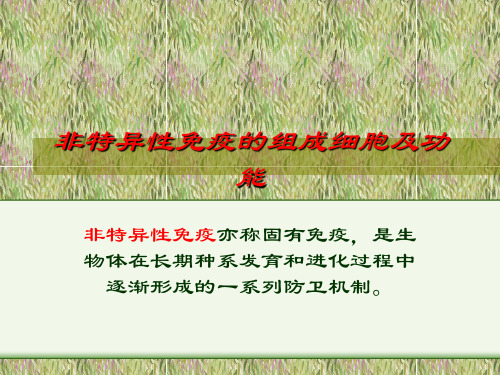
©2001 免疫学信息网
γδT细胞的抗原识别谱和生物学功能
• γδT细胞可直接识别:感染后产生的热休 克蛋白;感染后异常表达于受感染细胞 表面的脂类抗原;CD1分子复合物;某 些病毒蛋白;分支杆菌产生的小磷酸化 非肽分子。 • γδT细胞具有抗感染和抗肿瘤作用
©2001 免疫学信息网
第二节 参与非特异性免疫作用 的细胞
• 上皮细胞及其附属成分的作用 机械屏 蔽作用、上皮细胞更新、呼吸道纤毛摆 动等;分泌抗菌作用的物质;正常菌群; M细胞→摄取细菌→转运穿过M细胞,进 入黏膜下结缔组织→Mφ摄取→携Ag进入 局部淋巴结→产生特异性免疫应答。
©2001 免疫学信息网
第一节 非特异性抗感染免疫 的作用时相
初次感染时,非特异性免疫应答可分为以 下三个时相 • 即刻非特异性免疫应答阶段 发生于感 染0-4小时之内。 • 早期非特异性免疫应答阶段 发生在感 染后4-96小时之内。 • 特异性免疫应答诱导阶段Байду номын сангаас
抗原递呈细胞和特异性免疫应答的诱 导
• APC细胞 • MHC-抗原肽复合物的形成
©2001 免疫学信息网
非特异性免疫的组成细胞及功 能
非特异性免疫亦称固有免疫,是生 物体在长期种系发育和进化过程中 逐渐形成的一系列防卫机制。
• 参与非特异性免疫的细胞主要包括皮肤 黏膜上皮细胞、吞噬细胞、NK细胞、 NK1.1+T细胞、γδT细胞和B-1B细胞 • 特异性免疫 是个体在生命过程中接受 抗原性异物刺激后,主动产生或接受免 疫球蛋白分子后被动获得的,又称适应 性免疫。主要参与细胞是T、B细胞和抗 原提呈细胞
©2001 免疫学信息网
• 两种受体对NK细胞杀伤作用的调节 NK 细胞通过表面活化受体与自身组织细胞、 病毒感染细胞和某些肿瘤细胞表面相应 糖类配体结合,可经活化受体信号转导 途径,产生杀伤作用;通过表面杀伤抑 制受体与细胞表面MHC-I类分子结合, 可产生杀伤抑制信号,该信号在胞内起 主导作用,能阻断杀伤信号的传递。
固有免疫ppt课件

不经C1、C4、C2活化,而是在B因子、D因子和P因子 (备解素)参与下,直接由C3b与激活物结合而启动补体连锁 反应,产生一系列生物学效应,最终导致细胞溶解破坏的补体 活化途径,称为补体激活的旁路途径,又称替代或第二途径。 旁路途径可在细菌感染的早期,机体尚未产生特异性抗体时就 被激活,因此在机体抗感染免疫中具有重要的意义。
三、补体激活过程的调节
➢C1抑制物(C1 inhibitor, C1INH):与活化的C1分子中的C1r-
C1s共价结合,使活化的大分子C1裂解,从而导致C1酯酶失活,丧失酶解 正常底物的能力。
➢C4结合蛋白(C4 binding protein, C4bp):与C4b结合,辅助I
因子裂解液相中的C4b;竟争抑制C4b对C2b的结合,阻止经典途径C3转化 酶的形成;从C3转化酶中解离置换C2b,促进经典途径C3转化酶衰变灭活。
具有酶活性的成分或复合物
(在其符号上划一横线表示) 如C1、C3bBb
灭活的补体片段
(在其符号前加英文字母i表示) 如iC3b。
4. 补体的理化性质
所有补体成分均为球蛋白,含糖,但不含脂质。 补体在血清中含量稳定。 电泳中,补体大多属于β球蛋白。 补体各成分的分子量变化范围很大。 补体在56摄氏度时30分钟可以灭活。 补体固有成分被激活后才能发挥作用。
➢I因子(factor I):能使C4b和C3b裂解灭活,从而对经典和旁路途径
C3转化酶的形成产生限定抑制作用。
➢S蛋白(S protein, SP):能与 C5b67复合物结合,使之丧失与膜结
合的活性,从而阻止C5b6789膜攻击复合物的形成,又称膜攻击复合物抑制 因子。
CD59的主要生理功能是,防止MAC对同种或自身细胞的溶解破坏,即同种 限制作用(homologous species restriction,HSR)。作用机理为:通过其与C7、 C8或C9的结合而阻止MAC组装。当其与C5b~7复合物结合后,可阻止其再 与C8结合;当其与C8结合后,则可阻碍结合至MAC上的第1个C9分子的铺展, 从而是阻止后继C9的结合;而当其与MAC中的C9结合后,又可阻止C9进一 步分子的聚合。这样,在有CD59存在的情况下,在同种或自身细胞的表面 便不能顺利地完成MAC的全部组装,或不能组装成C5b~(9)n复合物,从 而限制了对同种或自身细胞的溶解作用。
免疫学词汇(中英文)

classical complement pathway补体经典途径
clonal selection theory克隆选择学说
complementary determining regions(CDRs)互补决定区
complement system补体系统
antigen抗原
antigen-bingding site(paratope)抗原结合位点
(抗体结合部位;抗体决定簇)
antigen presentation抗原呈递
antigen presenting cell抗原呈递细胞
apotosis凋亡
autograft自身移植物,自身移植术
L选择素
lymph nodes淋巴结
lymphopoiesis淋巴细胞增殖,淋巴组织生成
lymphotoxin淋巴毒素
macrophage巨噬细胞
major histocompatibility complex(MHC)
主要组织相容性复合体
mantle zone冠状带
marginal zone and sinus边缘区和静脉窦
cortex皮质、皮层、脑皮层
co-stimulatory molecules共刺激分子
cyclosporin A
环孢菌素A
cytokines细胞因子、细胞激素
D(diversity)gene segment多样性基因片段
Diapedesis血球渗出
eosinophils嗜酸性球,嗜曙红细胞
epitope表位
FAS细胞凋亡因子
follicular dendritic cells滤泡状树突状细胞
免疫细胞ppt课件

.
特异性T细胞免疫应答和记忆细胞的形成过程
抗原
抗原 提呈 细胞
效应CD4+T
凋亡
细胞因子
初始T淋巴细胞 效应CD8+T
凋亡
细胞毒杀 伤功能
记忆CD4+T细 胞
清除病原体
记忆CD8+T细 胞
.
初始、效应和记忆T细胞的功能特征
功能特征 初始T细胞 效应T细胞
特殊T细胞亚群,组成性表达NK1.1分子和 TCR-CD3复合物;主要为CD4-CD8-T细胞;
主要分布于骨髓、肝、脾、胸腺; 大多数为TCRαβ型,少数为TCRγδ型,TCR
缺乏多样性,密度低; 抗原识别谱窄且不受MHC限制,TCR识别
CD1分子提呈的脂类。
.
NKT细胞
生物学功能:
细胞毒作用: 分泌穿孔素,或通过FasL/Fas途径诱导 细胞凋亡
免疫细胞
Immune Cells
中山大学中山医学院免疫学教研室 彭延文
.
免疫系统的组成
免疫器官:中枢免疫器官和外周免疫器官
免疫细胞:造血干细胞、淋巴细胞、抗原提呈
细胞、粒细胞和红细胞等 免疫分子:免疫球蛋白、补体、各种细胞因子等
.
.
.
免疫应答的分类
固有免疫(非特异性免疫):进化中形成
的,出生即具备,非特异性抵抗的防卫机制。
骨细胞、胸腺巨噬细胞等。
中性粒细胞(neutrophils)
含初级和次级颗粒;总WBC的50-70%;寿
命短;强趋化作用和吞噬功能,作用早。
.
单核吞噬细胞的功能 ——识别、吞噬杀伤和清除抗原异物
医学免疫学英文词汇知识

AAcquired immune deficiency syndrome, AIDS 获得性免疫缺陷综合征(艾滋病) Acquired immunity 获得性免疫Activation induced cell death, AICD 活化诱导的细胞死亡Active immunotherapy 主动免疫治疗Acute phase protein 急性时相蛋白Adapter 转接蛋白Adaptive immunity 适应性免疫Addressin 地址素Adenosine deaminase 腺苷脱氨酶Adjuvant 佐剂Adoptive immunity 过继免疫Adoptive immunotherapy, AIT 过继免疫治疗Affinity 亲和力Affinity maturation 亲和力成熟Agglutination 凝集反应Allelic exclusion 等位排斥Allergen 变应原Allergin 变应素Allergy 变态反应Allogenic antigen 同种异型抗原Allograft 同种异型移植Allotype 同种异型Allorecognition 同种异型识别Alpha-fetoprotein, AFP 甲种胎儿球蛋白Alternative pathway 旁路途径Anamnestic response 回忆应答Anaphylactic shock 过敏性休克Anaphylactogen 过敏原Anaphylaxis 过敏反应Anchor residue 锚定残基Ankylosing spondylitis, AS 强直性脊柱炎Antibacterial immune serum 抗菌免疫血清Antibody, Ab 抗体Antibody-dependent cell-mediated cytotoxicity, ADCC 抗体依赖性细胞介导的细胞毒作用Antiviral immune serum 抗病毒免疫血清Antigen, Ag 抗原Antigenic determinant 抗原决定簇Antigen internal image 抗原内影像Antigen-presenting cells, APC 抗原提呈细胞Antigen specific immune response 抗原特异性免疫应答Antigenicity 抗原性Anti-idiotype 抗独特型Antitoxic serum 抗毒素血清Apoptosis 细胞凋亡Apoptosis cell associated molecular pattern, ACAMP凋亡细胞相关的分子模式 Apoptotic body 凋亡小体Artificial active immunization 人工主动免疫Artificial passive immunization 人工被动免疫Ataxia telangiectasia syndrome, AT 毛细血管扩张共济失调综合征 Atopic dermatitisAutocrineAutograftAutoimmune antibodyAutoimmune disease, AIDAutoimmune hemolytic anemiaAutoimmune thrombocytopenic purpuraAutoimmunityBBacillus Calmette Guerin, BCGBare lymphocyte syndrome, BLSBasophilB cell epitope BB cell hybridoma BB cell linker ptotein, BLNKB cell receptor, BCRBiotin-avidin system, BASBispecific antibody, BsAbBlocking antibodyB lymphocyteBone marrowBone marrow transplantation, BMTBradykininCC1 inhibitor, C1 INHC4 binding protein,C8 binding protein, C8bpC-reactive protein,CRPCadherinCalcineurinCalmodulinCarcinoembryonic antigen, CEACarrierCecropinsCell adhesion molecules, CAM 特应性皮炎自分泌自体移植自身抗体自身免疫性疾病自身免疫性溶血性贫血自身免疫性血小板减少性紫癜自身免疫卡介苗裸淋巴细胞综合征嗜碱性粒细胞细胞表位细胞杂交瘤 B 细胞连接蛋白 B 细胞(抗原识别)受体生物素-亲和素系统双特异性抗体封闭抗体 B淋巴细胞骨髓骨髓移植缓激肽C1抑制分子 C4bp C4 结合蛋 C8 结合蛋白 C-反应蛋白钙粘蛋白钙神经素(钙调磷酸酶)钙调蛋白癌胚抗原载体杀菌肽细胞粘附分子hediak-Higashi syndrome Chediak-Higashi综合征 Chemokine 趋化性细胞因子 Chimeric antibody 嵌合抗体Chronic granulomatous disease, CGD 慢性肉芽肿病 Class Ⅱtransactivator, C ⅡTA Ⅱ类反式活化子 Class switch 类别转换Classical pathway 经典途径Clonal anergy 克隆无能Clonal deletion 克隆删除Clonal eliminationClonal expansionCluster of differentiation, CDColony stimulating factor, CSFCommon variable immunodeficiencyComplementComplement deficiencyComplement receptorComplementarity determining region, CDRComplete antigenConcanavalin A, Con AConformational determinantConstant regionCo-receptorCo-stimulating signalCo-stimulatory molecules, CMCo-stimulatory molecule receptor, CMR Cross reactionCryptic determinantCytokine, CKCytolytic typeCytotoxic typeCytotoxic T lymphocytes, CTL 或 Tc Cytotoxic T lymphocytes antigen-4, CTLA-4 DDecay accelerating factor, DAFDefensinsDelayed type hypersensitivity, DTHDelayed type hypersensitivity T cell, T DTH Dendritic cells, DCDiGeorge syndromeDiversity geneDNA vaccineDonorDouble immunodiffusion 克隆消除克隆扩增分化群集落刺激因子普通变化型免疫缺陷病补体补体缺陷补体受体互补性决定区完全抗原刀豆蛋白A 构象决定基恒定区,C区辅助受体协同刺激信号协同刺激分子协同刺激分子受体交叉反应隐蔽决定基细胞因子细胞溶解型细胞毒型细胞毒性T细胞细胞毒性T淋巴细胞(相关)抗原 4 衰变加速因子防御素迟发型超敏反应迟发型超敏反应性T细胞树突状细胞 DiGeorge综合征 D(多样化)基因 DNA疫苗供者双向免疫扩散Double negative cell, DN cell 双阴性细胞Double positive cell, DP cell 双阳性细胞EE rosette test E 花结试验Early phase reaction 早期相反应Endocytosis 胞吞作用Enzyme immunoassay, EIA 酶免疫测定Enzyme linked immunosorbent assay, ELISA 酶联免疫吸附试验Eosinophil, Eos 嗜酸性粒细胞Eosinophil chemotactic factor, ECF 嗜酸性粒细胞趋化因子Eosinophil peroxidase, EPO 嗜酸性粒细胞过氧化物酶 Epitope 表位Erythropoietin, EPO 红细胞生成素Extracellular matrix, ECM 细胞外基质F Fc receptor, FcR 结晶片断受体,Fc受体 Flow cytometry, FCM 流式细胞术Fluorescence-activated cell sorter, FACS 荧光活化细胞分类器 Follicular dendritic cells, FDC 滤泡树突状细胞 Fragment antigen binding, Fab 抗原结合片断Fragment crystallizable, Fc 结晶片断Fragment of variable region Fv 片断Framework region 骨架区Freund complete adjuvant 弗氏完全佐剂GGenetic engineering antibody 基因工程抗体Germ line gene 胚系基因Germinal center 生发中心Glycosylphosphatidylinositol, GPI 糖磷脂酰肌醇Graft versus host reaction, GVHR 移植物抗宿主反应 Granule exocytosis 颗粒胞吐Granulocyte colony stimulating factor, G-CSF 粒细胞集落刺激因子 Granulocyte-macrophage colony stimulating factor, GM-CSF 粒细胞-巨噬细胞集落刺激因子 Granzyme, Gz 颗粒酶Grave disease 毒性弥漫性甲状腺炎 Growth factor 生长因子Growth factor receptor binding protein-2,Grb-2 生长因子受体结合蛋白 2 Guanine nucleotide exchange factor, GEF 鸟苷酸置换因子Gut-associated lymphoid tissue, GALT 肠伴随(相关)淋巴组织 HHaplotype 单元型Hapten 半抗原Hashimoto’s thyroiditis 桥本甲状腺炎Heat shock protein, HSP 热休克蛋白Heavy chain 重链,H 链Helper T cells(lymphocytes), Th 辅助性 T 细胞 Hemolytic plaque assay 溶血空斑试验 Hemopoietic stem cell, HSC 造血干细胞 Heterophil antigen 异嗜性抗原 Hidden antigen 隐蔽抗原High endothelial venule, HEV 高内皮细胞小静脉 Hinge region 铰链区Histamin 组胺Histocompatibility antigen-2, H-2HLA genotypingHomologous restriction factor, HRFHost versus graft reaction, HVGRHuman immunodeficiency virus, HIVHuman leukocyte antigen,HLAHumanized antibodyHumoral immunity Hypersensitivity Hypervariable region, HVRIIdiotype, IdIdiotype networkImmediate hypersensitivity Immune adherent, IAImmune complex, ICImmune function related gene Immune regulationImmune responseImmune response region Immune serumImmune surveillanceImmune systemImmunityImmunocyteImmunodeficiency disease, IDD Immunofluorescence Immunogenicity'\ Immunoglobulin, IgImmunoglobulin superfamily, IgSFImmunohistochemistry techniqueImmunological competenceImmunological ignorance , ;Immunological toleranceImmunological non-responsiveness 小鼠的组织相容性抗原HLA 基因分型同源限制因子宿主抗移植物反应人类免疫缺陷病毒人类白细胞抗原人源化抗体体液免疫超敏反应高变独特型独特型网络速发型超敏反应免疫粘附免疫复合物免疫功能相关基因免疫调节免疫应答免疫应答区免疫血清免疫监视免疫系统免疫免疫细胞免疫缺陷病免疫荧光法免疫原性免疫球蛋白免疫球蛋白超家族免疫组化技术免疫适能免疫忽视免疫耐受免疫不应答Immunologically privileged sites 免疫隔离部位Immunology 免疫学Immunoreceptor tyrosine-based activation motifs, ITAM 免疫受体酪氨酸活化基序 Immunoreceptor tyrosine-based inhibitory motifs, ITIM 免疫受体酪氨酸抑制基序 Immunotherapy 免疫治疗Inactivated vaccine 灭活疫苗Inducible nitric oxide synthase, iNOS 诱导型一氧化氮合成酶Inflammatory cell 炎症细胞Innate immunity 固有(性)免疫'\ Inositol-1, 4, 5-trisphosphate,IP3Insulin-dependent diabetes mellitus, IDDMIntercellular adhesion molecular,ICAMIntegrinInterferon, IFNInterleukin, ILInternalizationImtraepithelial lymphocytes, IELJJoining chainJoining geneKKiller activatory receptor, KARKiller inhibitory receptor, KIRKiller immunoglobulin like receptorKininogenaseLLangerhans cells, LCLarge granular lymphcytes, LGLsLate phase reactionLectinLectin-like carbohydrate recognition domain, CRDLeucine rich repeat, LRRLeukinLeukocyte adhesion deficiency, LADLeukocyte common antigen, LCALeukocyte differentiation antigen, LDALeukotrienes (Leucotrienes), LTsLigandLight chainLinker for activation of T cell, LATLinear determinantLinkage disequilibriumLipoteichoic acid, LTALipoxygenase pathway 三磷酸肌醇胰岛素依赖型糖尿病细胞间粘附分子整合素干扰素白细胞介素内化上皮细胞间淋巴细胞 J链J基因杀伤细胞活化受体杀伤细胞抑制受体杀伤细胞免疫球蛋白样受体激肽原酶郎格汉斯细胞大颗粒淋巴细胞晚期相反应凝集素凝集素样糖识别结构域富含亮氨酸的重复序列白细胞素白细胞粘附缺陷白细胞共同抗原白细胞分化抗原白三烯配基,配体轻链,L 链 T细胞活化连接蛋白线性决定基连锁不平衡磷壁酸脂氧合酶途径Live-attenuated vaccine 减毒活疫苗Long-acting thyroid stimulator, LATS 长效甲状腺刺激素Low molecular-weight polypeptide, LMP 低分子量多肽LPS binding protein, LBP LPS结合蛋白Lymphocyte 淋巴细胞Lymphocyte function associated antigen, LFA 淋巴细胞功能相关抗原 Lymphocyte homing 淋巴细胞归巢Lymphocyte homing receptor, LHR 淋巴细胞归巢受体Lymphoid DC 淋巴系树突状细胞Lymphoid progenitor 淋巴样祖细胞Lymphoid stem cells, LSC 淋巴样干细胞Lymphokine, LK 淋巴因子Lymphokine activated killer cell, LAK 淋巴因子激活的杀伤细胞 Lymphotoxin, LT 淋巴毒素β -lysin 乙型溶素Lysosome-associated membrane proteins-1,LAMP-1 溶酶体相关膜蛋白1 Lysozyme 溶菌酶MMacrophages, M φ 巨噬细胞Macrophage colony stimulating factor, M-CSF 巨噬细胞集落刺激因子 Macropinocytosis 巨吞饮Magainins 爪蟾抗菌肽Major histocompatibility complex, MHC 主要组织相容性复合体 Mannan-binding lectin, MBL 甘露糖结合凝集素Mannose binding protein, MBP 甘露糖结合蛋白Mannose receptor, MR 甘露糖受体Mast cell, MC 肥大细胞MBL-associated serine protease, MASP MBL 伴随的丝氨酸蛋白酶 Membrane attack complex, MAC 膜攻击复合物Membrane cofactor protein, MCP 膜辅助因子蛋白Membrane Ig, mIg 膜表面免疫球蛋白Membrane inhibitor of reactive lysis, MIRL 膜反应性溶解抑制物 Memory cells 记忆细胞MHC class Ⅰgene MHC Ⅰ类基因MHC class Ⅱgene MHC Ⅱ类基因MHC class Ⅲgene MHC Ⅲ类基因MHC restriction MHC 限制性Microfold cell M细胞,微小褶皱细胞β 2-Microglobulin, β2 -m β2 微球蛋白Minor histocompatibility antigen 次要组织相容性抗原 Mitog en 丝裂原Mitogen-activation protein kinase, MAPK 丝裂原激活蛋白激酶 Molecular mimicry 分子模拟Monoclonal antibody, McAb 单克隆抗体第7 / 11页Monocyte 单核细胞Monocyte chemotactic protein, MCP 单核细胞趋化蛋白Monokine, MK 单核因子Mononuclear-phagocyte system, MPS 单核-巨噬细胞系统Mucosal-associated lymphoid tissue, MALT 粘膜伴随(相关)淋巴组织 Mucosal mast cell, MMC 粘膜肥大细胞Multiple hematopoietic stem cells, HSC 多能造血干细胞Multiple sclerosis, MS 多发性硬化症Myasthenia gravis, MG 重症肌无力Myeloid DCMyeloid stem cellMyeloperoxidase, MPONNaive T(B) cellsNatural cytotoxic cellNature killer cell, NK cellNeutrophilsNitric oxide, NONitroblue tetrazolium, NBTNon-classical MHC class ⅠgeneNon-organ specific autoimmune diseaseNon-specific immunityNude miceOOpsonizationOrgan specific autoimmune diseasePParacrineParoxysmal nocturnal hemoglobineria, PHNPassive immunotherapy ,Passive transfer of lymphocytePathogen associated molecular pattern, PAMPPattern recognition receptor, PRRPeptide antibioticsPeptidoglycan, PGNPerforinPeripheral lymphoid organPeyer’s patchesPhagocytePhagocytosisPhagolysosomePhosphatidylinnosital pathway 髓系树突状细胞髓样干细胞髓过氧化物酶初始T(B)细胞自然细胞毒性细胞自然杀伤细胞嗜中性粒细胞一氧化氮氮蓝四唑非经典性Ⅰ类基因非器官特异性自身免疫病非特异性免疫裸小鼠,裸鼠调理作用器官特异性自身免疫病旁分泌夜间血红蛋白尿被动免疫治疗淋巴细胞被动转移病原相关分子模式模式识别受体肽抗菌肽聚糖穿孔素外周淋巴器官派氏集合淋巴结吞噬细胞吞噬作用吞噬溶酶体 PI途径第8 / 11页Phosphatidylinositol-3-kinase, PI3-K 磷脂酰肌醇3激酶Phosphatidylinositol-4,5-bisphosphate, PIP 2 磷脂酰肌醇4,5二磷酸 Phosphatidylinositol-3,4,5-trisphosphate 磷脂酰肌醇3,4,5三磷酸 Phosphatidylserine, PS 磷脂酰丝氨酸Phosphoinositides 磷酸肌醇Phospholipase 磷脂酶Phospholipid bilineurine 磷脂胆碱Phosphotylinositide-3 kinase 磷酸肌醇-3激酶Phytohemagglutinin, PHA 植物血凝素PinocytosisPinocytotic vesiclePlacental γ globulinPlaque forming cell, PFCPlasma cellsPlatelet activating factor, PAFPolymeric Ig receptor, pIgRPolymorphismPolymorphic genesPolymorphonuclear neutrophils, PMN PrecipitationPrimary immunodeficiency disease, PIDD Primary responsePro-B cellprofessional antigen presenting cells Programmed cell death, PCDProperdin, PProstaglandin, PGProtein kinase C, PKCProtein tyrosine kinase, PTKProtein tyrosine phosphatase, PTP/PTPase Proteolytic enzyme complexProteosomePurine nucleotide phosphorylase, PNPRγδ+T cellRadioimmunoassay, RIAReactive nitrogen intermediates, RNIs Reactive oxygen intermediates, ROIs RearrangementReceptor editingReceptor-mediated endocytosisRecipientRecombinant antigen vaccineRecombinant vector vaccine 胞饮作用吞饮泡胎盘丙种球蛋白空斑形成细胞浆细胞血小板活化因子多聚免疫球蛋白受体多态性多态性基因多形核嗜中性粒细胞沉淀反应原发性免疫缺陷病初次应答祖B细胞专职抗原提呈细胞程序性细胞死亡备解素前列腺素蛋白激酶C 蛋白酪氨酸激酶蛋白酪氨酸磷酸酶蛋白水解酶复合体蛋白酶体嘌呤核苷磷酸化酶γδ+T细胞放射免疫测定法反应性氮中间物反应性氧中间物(基因)重排受体编辑受体介导的胞吞作用受者重组抗原疫苗重组载体疫苗第9 / 11页Recombinase 重组酶Recombination activating genes, RAG 重组活化基因Recombination signal sequences, RSS 重组信号序列Rejection (移植物的)排斥Rheumatoid arthritis, RA 类风湿性关节炎Rheumatoid factor, RF 类风湿因子SScavenger receptor, SR 清杂受体Secondary immunodeficiency disease, SIDD 继发性免疫缺陷病Secondary response 再次应答Secretory component, SC 分泌成分,分泌小体Secretory IgA, sIgA 分泌型免疫球蛋白 ASecretory piece, SP 分泌片Selectin 选择素Selective IgA deficiency 选择性IgA缺陷Serin/threonine phosphatase 丝/苏氨酸磷酸酶Serum amyloid pretein A, SAA 血清淀粉样蛋白 ASevere combined-immunodeficiency disease, SCID 重症联合免疫缺陷病 Signal transduction 信号转导Signal transducers and activator of transcription, STAT 信号转导和活化转录因子 Signalling complex 信号复合体Single immunodiffusion 单向免疫扩散Small G protein 小 G 蛋白Sneaking through 漏逸Soluble TNF receptor, sTNFR 可溶性TNF受体Somatic hypermutation 体细胞高(频)突变Specific immunity 特异性免疫Split tolerance 耐受分离Src family kinase Src家族激酶Staphylococcus enterotoxin, SE 葡萄球菌肠毒素Staphylococcus protein A, SPA 葡萄球菌蛋白 AStem cell factor, SCF 干细胞(生长)因子Subunit vaccine 亚单位疫苗Superantigen, SAg 超抗原Suppressor T cells, Ts 抑制性T细胞Syngraft 同种基因移植,同型移植 Synthetic peptide vaccine 合成肽疫苗Systemic lupus erythematosus, SLE 系统性红斑狼疮TT cell epitope T细胞表位T cell receptor, TCR T细胞(抗原识别)受体 T lymphocyte T 淋巴细胞TCR/CD3 complex TCR/CD3 复合物Terminal deoxynucleotidyl transferase, TdT 末端脱氧核苷酸转移酶第10 / 11页Terminal pathway 末端通路Thrombopoietin 血小板生成素Thymic stromal cells, TSC 胸腺基质细胞Thymocyte 胸腺细胞Thymus 胸腺Thymus dependent antigen, TD-Ag 胸腺依赖抗原Thymus epithelial cells, TEC 胸腺上皮细胞Thymus independent antigen, TI-Ag 非胸腺依赖抗原Thyroid stimulating hormone, TSH 促甲状腺激素Tolerogen 耐受原Toll like receptor, TLR Toll样受体Toxoid &nbs, p; 类毒素Transforming growth factor, TGF 转化生长因子Transporters associated with antigen processing,TAP 抗原处理相关转运蛋白 Tumor-associated antigen, TAA 肿瘤相关抗原Tumor necrosis factor, TNF 肿瘤坏死因子Tumor-specific antigen, TSA 肿瘤特异性抗原VVariable folding 可变折叠Variable geng V基因Variable region ( V region ) 可变区,V区Vitronectin 玻璃连接蛋白,玻连蛋白 Very late appearing ant igen, VLA 迟现抗原WWestern blotting 免疫印迹法Wiskott-Aldrich syndrome, WAS 伴湿疹血小板减少性免疫缺陷病 XX-linked agammaglobulinemia, XLA 性联无丙种球蛋白血症 X-l inked hyperimmunoglobulin M syndrome, HIM 性联高IgM综合征 X-l inked SCID, XSCID 性联重症联合免疫缺陷病。
14 固有免疫细胞及功能

第一节 固有免疫系统的组成
一、组织屏障 二、固有免疫细胞 三、固有免疫分子
一、组织屏障及其作用
(一)皮肤粘膜屏障 • 物理屏障:致密上皮细胞组成的皮肤、粘膜组织、 纤毛定向摆动、粘膜分泌液冲洗作用 • 化学屏障:杀菌抑菌成分,不饱和脂肪酸、乳酸、胃酸、 溶菌酶、抗菌肽、乳铁蛋白 • 微生物屏障: H2O2,大肠杆菌细菌素 (二)体内屏障 • 血脑屏障:软脑膜、脉络丛毛细血管、星形胶质细胞 • 血胎屏障:子宫内膜的基蜕膜、胎儿绒毛膜滋养层细胞
病原体表面的甘露糖、岩藻糖和N‐乙酰葡萄糖胺 残基 细菌胞壁磷酰胆碱 G-菌脂多糖(LPS)
吞噬细胞 phagocytes
单核巨噬细胞(系统)
Mononuclear phagocyte system
中性粒细胞
neutrophils
单核细胞
monocyte
巨噬细胞
macrophage
• • • •
2. 浆细胞样DC: pDC, 高表达TLR7, TLR9, 可识别病毒核酸,快速产生大量Ⅰ型干扰素, 参与抗病毒固有免疫应答。
(四)自然杀伤细胞 NK
• 骨髓、外周血、肝、脾、肺、淋巴结 • 表面标志:TCR-, mIg- , CD56+、CD16+
(二)NK细胞表面受体
按受体功能分类: 1. 杀伤细胞活化性受体(killer activatory receptor) 2. 杀伤细胞抑制性受体(killer inhibitory receptor)
一、固有免疫的应答特点
• 通过模式识别受体或有限多样性抗原识别受体直 接识别病原相关分子模式 • 趋化募集,在感染部位直接被激活 • 产生多种细胞因子,参与适应性免疫应答全过程 • 寿命较短,不产生记忆
固有免疫细胞及功能(英文)
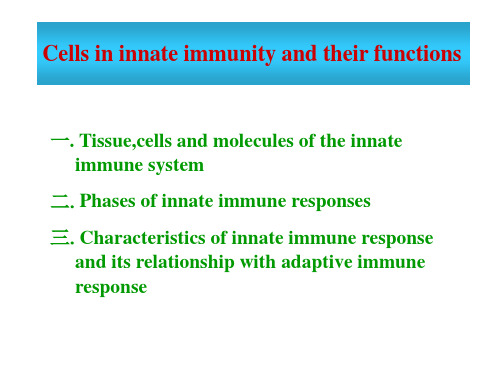
Other types of cells involved in the innate immunity:
Dendritic cell Eosinophil granulocyte Basophilic granulocyte
Mast cell
三. Innate effector molecules and their main function
固有免疫细胞及功能英文固有免疫细胞固有免疫细胞不表达固有免疫应答细胞细胞免疫功能检测细胞免疫功能细胞免疫功能检测指标免疫细胞的种类及功能细胞免疫功能低下免疫细胞英文
Cells in innate immunity and their functions
一. Tissue,cells and molecules of the innate immune system
The extracellular region of KIR recognize MHC-I of self cells →ITIM→ transduce inhibitory signals
Regulation of NK cell killing effect by two receptors
(三) Defensin
(四) Lysozyme
(五) β-Lysin
Section 2 Phases of innate immune response
Transient phase of innate immune response Early phase of innate immune response Induction Phase of adaptive immune rntimicrobial and cytotoxic activity
免疫细胞工作的重要性和意义英文作文
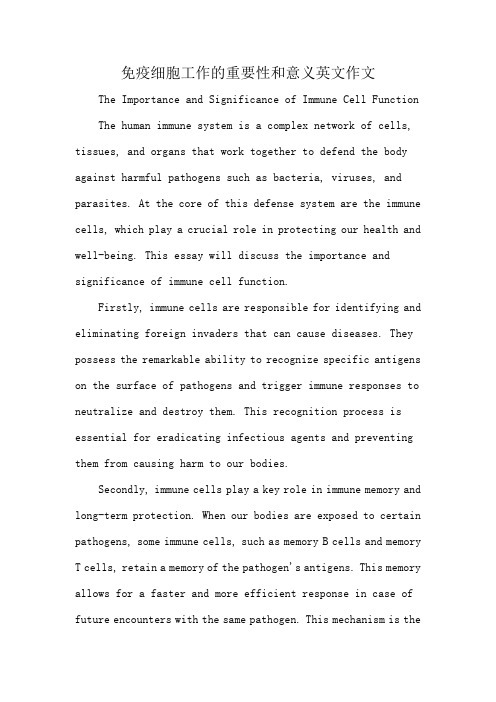
免疫细胞工作的重要性和意义英文作文The Importance and Significance of Immune Cell Function The human immune system is a complex network of cells, tissues, and organs that work together to defend the body against harmful pathogens such as bacteria, viruses, and parasites. At the core of this defense system are the immune cells, which play a crucial role in protecting our health and well-being. This essay will discuss the importance and significance of immune cell function.Firstly, immune cells are responsible for identifying and eliminating foreign invaders that can cause diseases. They possess the remarkable ability to recognize specific antigens on the surface of pathogens and trigger immune responses to neutralize and destroy them. This recognition process is essential for eradicating infectious agents and preventing them from causing harm to our bodies.Secondly, immune cells play a key role in immune memory and long-term protection. When our bodies are exposed to certain pathogens, some immune cells, such as memory B cells and memory T cells, retain a memory of the pathogen's antigens. This memory allows for a faster and more efficient response in case of future encounters with the same pathogen. This mechanism is thebasis for the effectiveness of vaccines, as they stimulate the production of memory cells without causing actual disease, providing long-lasting immunity.Furthermore, immune cells are involved in regulating and maintaining overall immune balance. They act as mediators to ensure that immune responses are appropriately activated and controlled. Too weak of an immune response may lead to increased susceptibility to infections, while an overactive immune response can result in allergies or autoimmune diseases. Immune cells coordinate their actions to maintain a delicate equilibrium, allowing for effective protection while avoiding excessive damage to our own tissues.Additionally, immune cells play a vital role in tissue repair and wound healing. They contribute to the clean-up process by removing dead cells and debris from injured or infected sites. They also release signaling molecules that promote the regeneration of damaged tissues and facilitate the healing process.In conclusion, immune cell function is of paramount importance and holds great significance for our health and well-being. Their ability to recognize, eliminate, and remember pathogens, maintain immune balance, and aid in tissuerepair ensures our protection against diseases. Understanding the intricacies of immune cell function is crucial for developing effective treatments and preventive strategies to combat infections and improve human health.。
固有免疫细胞和功能(英文)
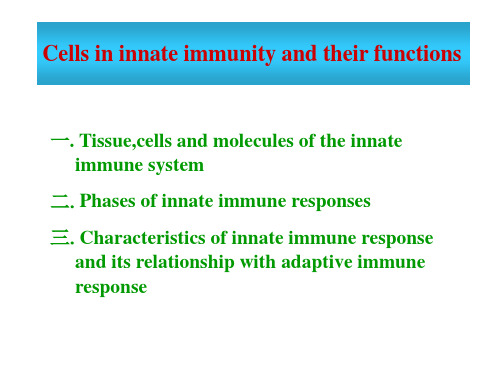
MHC-I and receptor of adhension molecules
Phagocytes
Biological functions
surface receptors of phagocytes
Antigen presentation
Intrinsic, Extrinsic
Anti-tumour
Antimicrobial and cytotoxic activity
Oxygen-dependent killing mechanisms
Reactive oxygen intermediates(ROIs) Neutrophil myeloperoxidase(MPO) Reactive nitrogen interr recognition: killer activatory receptor(KAR) killer inhibitory receptor(KIR)
KAR KAR recognize cell carbohydrate ligands →ITAM→transduce activation signals KIR The extracellular region of KIR recognize MHC-I of self cells →ITIM→ transduce inhibitory signals Regulation of NK cell killing effect by two receptors
(二) Blood-brain barrier (三) blood –fetus barrier
- 1、下载文档前请自行甄别文档内容的完整性,平台不提供额外的编辑、内容补充、找答案等附加服务。
- 2、"仅部分预览"的文档,不可在线预览部分如存在完整性等问题,可反馈申请退款(可完整预览的文档不适用该条件!)。
- 3、如文档侵犯您的权益,请联系客服反馈,我们会尽快为您处理(人工客服工作时间:9:00-18:30)。
Other types of cells involved in the innate immunity:
Dendritic cell Eosinophil granulocyte Basophilic granulocyte Mast cell
三. Innate effector molecules and their main function
(二) Blood-brain barrier (三) blood –fetus barrier
二. Cells involved in innate immunity and their functions Phagocute Natural killer cells γδ T cells NKT cells B1 cells
Phagocytes
Biological functions
Anti-infection Anti-tumor: directly contact and fuse with the tumour cell membrane ; cytotoxic substance, proteinase, cytolysin, TNF-α,ADCC mediated by tumor specific antibody Antigen processing and presentation Immunoregulation
一. Tissue barriers and their effection
(一)The skin and mucosal surfaces provide protective barriers against infection Physical barriers: epithelial, cilia, mucus Chemical barriers: lactic acid, unsaturated fatty acid, gastric acid Biological barriers: microorganisms
3. γδ T cell
Distributions: epithelia, mucosa surface markers: γδTCR, CD2/3/16/25/45, LFA-1,DN Molecular recognition: Narrow spectrum of antigen recognition:HSP, CD1 complex, viral proteins (VP) The same group of cells express only one kind of γδTCR : same specificity of antigen recognition—response to common antigen Biological Function: anti-infection in skin and mucosa, anti-tumor, immunoregulation
Recognized molecules
Corresponding carbohydrate and phosphatide LPS Antigens entrapped by C3b Antigens specially bound by IgG PAMP
Phagocytes Biological functions
Oxygen-dependent killing mechanisms
acid pH, lysozyme , lactoferrin, cationic protein, elastase
Secretion of factors
Released in appropriate or large quantities Cytokines:TNF-α, IL-1, IL-6, IL-8, IL-12, MCP-1 Inflammation mediators:prostaglandin E, LTB4, PAF, phosphatidase, peroxidate → Local inflammatory reaction(TNF-α、IL-1、 LTB4) → Fever and acute phase reaction(CRP、MBL) → Immunoregulation(IL-1、IL-6、IL-12)
Antimicrobial and cytotoxic activity
Oxygen-dependent, Oxygen-independent
Secretion of factors
Cytokines, Inflammantory mediators
Antigen presentation
Intrinsic, Extrinsic
Phagocytes
Biological functions
surface receptors of phagocytes
Mannitol, fucose, phosphatide receptor CR3, CR4 , CD14 C3bR FcγR Toll-like receptor scavenger
2. NK Cells
PBMC, Spleen
Large amount of azurophil granule in the cytoplasma Kill the target cells directly with no needs of preactivation surface markers:CD3-, CD56+, CD16+
(三) Defensin (四) Lysozyme (五) β-Lysin
Section 2 Phases of innate immune response
Transient phase of innate immune response Early phase of innate immune response Induction Phase of adaptive immune response
Section I Tissue,cells and molecules of the innate immune system
Innate Immunity
Acquired Immunity
Native Immunity
Adaptive Immunity
Nonspecific Immunity
Байду номын сангаас
NK cells
Molecular recognition: killer activatory receptor(KAR) killer inhibitory receptor(KIR) KAR KAR recognize cell carbohydrate ligands →ITAM→transduce activation signals KIR The extracellular region of KIR recognize MHC-I of self cells →ITIM→ transduce inhibitory signals Regulation of NK cell killing effect by two receptors
4. NKT cells
Distribution:liver, bone marrow, thymus surface marker: NK1.1, TCR-CD3 complex molecular recognition Narrow spectrum of antigen recognition :CD1 complex, without MHC restriction Biological function: anti-infection, anti-tumor, involved in immunoregulation by secreting cytokines
Cells in innate immunity and their functions
一. Tissue,cells and molecules of the innate immune system 二.Phases of innate immune responses 三.Characteristics of innate immune response and its relationship with adaptive immune response
NK cells
Biological Functions Anti-infection:lysis, IFN-γ and TNF-β Anti-tumor: directly contact and fuse with tumour cells membrane ADCC mediated by tumor specific antibodies Immunoregulation
Specific Immunity
Species development, formed evolutionally Possess from the time of birth,react rapidly , Non-specific anti-infection immunity, also involved in specific immunity
(一)complement system
(二)Cytokines 1. Cytokines to induce anti-viral ability 2. Cytokines to induce and promote Inflammatory reactions 3. Cytokines to induce and enhance anti-tumor abilities
1. phagocytes
Mononuclear phagocyte system
neutrophils
